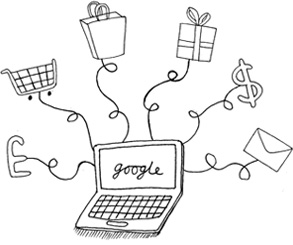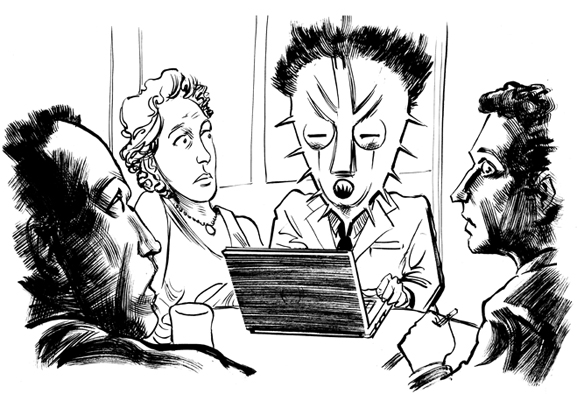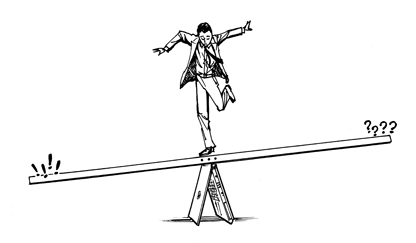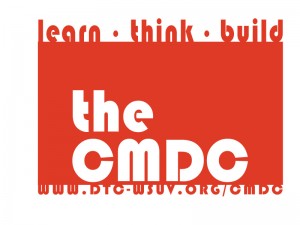Reading Responses
Preface / Introduction / Chapter One / Chapter Two
Chapter Three / Chapter Four / Chapter Five / Chapter Six / Chapter Seven
Chapter Summaries
Chapter Eight / Chapter Nine / Chapter Ten
Reflective Essay
1. Douglas Rushkoff thinks that learning how to program is essential at this point in time. Although he mentions that “the real answer is probably no” (7). It is possible to live without the knowledge or the capabilities of programming. However, he states that if you choose not to you will not be the driver of change, but instead take the role of a passenger (Rushkoff 9). On the other hand, Rushkoff advocates learning the basics of these technologies remarking that, “understanding programming “is the only way to truly know what’s going on in a digital environment, and to make willful choices about the roles we play” (8).
 Responses (Rushkoff, Introduction)
Responses (Rushkoff, Introduction)
1. Rushkoff argues that we need to learn to program in order to “gain access to the control panel of civilization” (13). He believes that the only true way to live in this new environment is to adapt these skills, in the end gaining the ability to control, not be controlled.
2. The title of Rushkoff’s book suggests the very same notion he expressses, either you will “create the software or you will be the software” (13). Grammatically?
3. The subtitles indicate that ten commands will be discussed in the book. These commands are what Rushkoff calls “biases of digital media” (26).
4. The ten commands are meant to provide us with a blueprint on how to balance digital biases with the needs of real people (Rushkoff 26). In essence, helping us understand how we engage with these tendencies as well as how we can differentiate between what we intend, and what the machines we’re using intend for us (Rushkoff 27).
5. Overall, this book’s purpose is to help guide us through the many overlooked intricacies of the digital realm. Truly, Rushkoff’s publication is meant to “forge a path through the digital realm”, in the end enhancing our knowledge and understanding of the electronic environment we inhabit today (26).
Responses (Rushkoff, Chapter One)
1. Synchronous and asynchronous are terms that refer to the timing of specific events (either occurring at the same time, or not). In this context, Rushkoff utilizes these words to explain our interactions via the Internet, stating that online experiences used to be “asynchronous”, whilst our daily activities now are “synchronous”.
2. Rushkoff views “multi-tasking” as an impossible achievement. He states that no one can truly focus on multiple tasks at the same time. Instead we “move as quickly as possible from one task to another” (35). Rushkoff argues that regardless of how proficient we think we are at “multi-tasking”, studies tell a different story, one in which our abilities to complete tasks accurately becomes increasingly diminished through this methodology (35).
3. The problem with allocating more of our mental resources into active RAM is the fact that we begin to rely even more heavily on electronic devices. Rushkoff surmises that we don’t just lose “the ability to remember certain facts, but to call upon certain skills” (39).
 Responses (Rushkoff, Chapter Two)
Responses (Rushkoff, Chapter Two)
1. Rushkoff’s example is of a hypothetical high school girl named Gina. In her life, she is “always on”, at all times perusing through her phone. She is living in a connected world, not in the real world.
2. When Rushkoff says “the bias of the networks were absolutely intended to favor decentralized activity”, he means that networks were intended to favor dislocated activities in which individuals are far apart.
3. This bias is particularly troublesome because human beings are both engaging in long distance activities and local ones. These local applications distance users from individuals in real life, making social engagements hard to control and manage.
Responses (Rushkoff, Chapter Three)
1. The example Rushkoff uses to describe the loss from analog to digital involves the comparisons between an analog record and a digital CD. Rushkoff reflects that the recording “is as smooth and continuous as real time,” while a CD “is a series of numerical snapshots” (53). In essence, one captures the whole event, while the other partially does this. As a result, there is a loss during this shift.
2. Rushkoff believes that the discreteness of binary code hurts us in the long run. Instead of these choices actually liberating us, they tie us down since we have to make them. We cannot choose to not make a choice. In the real world, we live without black and white decisions, instead having the freedom that no one can achieve through binary code.
3. “Tagging”, Rushkoff believes, is a systematic way in narrowing the “minds” of databases so that they can conform to our preferences. This deliberate form of bias is what Rushkoff warns others to think about and realize. In truth, it is just discrete binary choices in disguise.
 Responses (Rushkoff, Chapter Four)
Responses (Rushkoff, Chapter Four)
1. One of Rushkoff’s main problems with the “reduction of complexity” seen in the digital realm is that information can be found easily – the pursuit itself, minimized (63). Before this time, “the seeker had to jump through the hoops left by his predecessors. Now, the seeker can just get the answer” (Rushkoff 63).
2. Regardless of digital media’s loss of complexity, the ease of obtaining knowledge is also “democratizing”, allowing for individuals of any social rung to peruse information. Digital media, in essence, is a great mediator in terms of knowledge.
3. “Experimental learning” is the recreation of the process of discovery. It puts the individual “through the very motion of cognition rather than simply delivering the bounty” (Rushkoff 64). Digital media is eradicating this cognitive process through its bias of limited complexity. Digital media waters down the inquiry or search for information, in the end simplifying learning.
4. A “data point” is a piece of information or a standalone fact. It does not require further analysis or academic inquiry, and instead reflects little to no context.
5. The downside of a “data point” is its divorce from deeper meaning and context. It provides factual information, but it is only skin deep.
6. The positive aspect of a “data point universe” is its nonlinearity. Collaboratively, individuals can piece together information from a wide variety of disciplines and genres, taking advantage of the digital realm’s hypertext environment.
7. Rushkoff means that engagement with data is more and more about “knowing how not to know what one doesn’t have to know” (62). With our limited attention spans and information boom, discovering what is and what isn’t relevant is becoming more prevalent.
8. As digital technologies evolve, an ever-increasing gap between their complexity and our simplified experiences is emerging. We depend upon our technologies far more as they become smarter. We especially see this as smartphone interfaces improve; this spells less involvement and knowledge on the user end, in turn simplifying our actions.
9. An example that reflects the importance of simulation technologies is the concept of a weather system that can be studied in highly specified ways that are not capable in the real world. This is turn isolates its context in an engaging environment.
 Responses (Rushkoff, Chapter Five)
Responses (Rushkoff, Chapter Five)
1. The term “abstraction” is defined as the quality of dealing with ideas rather than events. Within the context of the digital realm, levels of “abstraction” separate businesses, and the only way to out-compete is to rise in “abstraction” or in scaling in (this naturally comes as a disadvantage to local companies).
2. Rushkoff means that digital technologies are more biased towards universal scaling. This means that those companies that can’t function at the desired level are hurt, while those who rise to this scale or higher achieve success.
3. Rushkoff uses the example of Tom, a local music retailer who decided to go online with his business. By doing this, he had to lose his “mom and pop” advantage and instead conform to the bias of universal scaling and abstraction.
4. A “vertical” approach to business is the idea of establishing yourself as the place to do everything, a one-stop shop for everyones basic or luxury goods. On the other hand, a “horizontal” approach to business is the process of offering a service that applies to every aspect of a category’s transactions.
5. The reason why “vertical” and “horizontal” approaches aren’t perfect in the digital realm because these clear-cut methods are difficult to rely upon in such a highly charged environment. With the atmosphere constantly changing, establishing a foothold is nearly impossible.
6. Scaling up resulted in a loss of manufacturing because of the digital realm’s apparent bias towards the interests of the lender, not the producer. This caused expansion of capital leasing and banking at the expense of factories.
7. An example of Rushkoff’s statement: “What all this abstraction does accomplish here on earth, however, is make everyone and everything more dependent on highly centralized standards”, is the fact that without a search engine we would be lost (71). It is our dependence on these processes that further cements their authority in this realm. Everything is set and dependent upon highly centralized standards, that is why universal scaling occurs and ultimately hurts businesses that find it difficult to conform.
8. Rushkoff brings up the important notion that all media are biased towards abstraction, citing the process of disconnection as the cause. He describes that “speech disconnected the doer from the deed,” and that “text, meanwhile, disconnected speech from the speaker,” and so on (78). In the end, it’s these representations and their disconnections that create a biased atmosphere towards abstraction.
9. Digital technologies are “one further level removed from what we think of as reality” in that all of the abstractions we engage in are simulations. In other words, “digital simulations are abstracted representations of” abstractions (Rushkoff 83).
 Responses (Rushkoff, Chapter Six)
Responses (Rushkoff, Chapter Six)
1. Our “digital experiences” are “out-of-body” since they occur in a digital space, not a physical one. Instead of us interacting personally or “in-body”, we interact behind a screen, in the end depersonalizing our behavior and choices.
2. Anonymity is dangerous in an online environment because we experience less of the human repercussions whenever we interact with others. This makes selfish or bad choices tempting, since the repercussions are sometimes either not felt or even imposed upon the user. On the other hand, identity is a liability in the digital atmosphere because of anonymity and its often hostile ends.
3. An example in which someone using digital media can act without repercussion is commonly seen on websites where you can post comments. Here, anonymity promotes heightened instances of “flame wars” or abuse without the fear of consequences.
4. Asperger’s Syndrome is a disorder that creates a “dependence on the verbal over the visual, a low pickup on social cues and facial expressions, apparent lack of empathy, and the inability to make eye contact” (Rushkoff 92). He connects this disorder to online social conduct because it describes any of us participating in the digital realm: typing to one another, misunderstanding messages, insulting each other unintentionally, etc.
5. The “real costs” of anonymity on the net are connected to the civility, integrity, and openness of our society. Once we surrender to anonymity we become even less present and responsible, in turn perpetuating an endless battle against the temptation that comes with anonymity.
 Responses (Rushkoff, Chapter Seven)
Responses (Rushkoff, Chapter Seven)
1. When Rushkoff talks about “the coevolution between people and technologies” he is paralleling Katherine Hayles’ thoughts about “technogenesis”, the idea that the digital realm changes as we evolve as a species.
2. The original intent of the Internet was to aid in the conducting of research and collaborative problem solving. However, the Internet caught on beyond its intended use due to the hobbies and interests of scientists who utilized more of their time discussing their favorite subjects rather than business.
3. An example that reflects Rushkoff’s claim, “content is not king – contact is,” is the explosion of social media applications available today. Conversations between individuals make up most of the online activities we participate in, in the end making contact far more essential than content.
4. Social media ultimately causes us to monetize and exploit our friends in main part due to the ruthlessness of social networking site companies, whose main goal is business. These companies put a price on social media and the exchange of information within them. It is this deliberate monetization that rubs off on individuals. One prominent example is the addictive game library hosted within social media applications. These games are not just games however, they also take the form of spam, which is then purposefully unleashed by the game user to further their success in the game.
5. According to Rushkoff, the driving force behind our use of social media is the instinctual urge for increased contact with those around us.
Summary (Rushkoff, Chapter Eight)
Within Chapter VIII of Rushkoff’s Program or be Programmed, Rushkoff argues that the digital realm is biased against fiction and towards facts. To begin, Rushkoff connects the peer-to-peer activity of the Internet to the bazaar of long ago. This foundation of knowledge he says, left the hands of citizens, transforming the world into one based upon myths perpetuated by mass media. The author points out that it’s the interactivity of digital technology that broke this trend, in the end promoting peer-to-peer communication, and with it a fact-based digital realm.
Summary (Rushkoff, Chapter Nine)
In Chapter IX of Rushkoff’s Program or be Programmed, Rushkoff contends that the digital realm is biased towards openness and sharing, but that we often exploit these collaborative efforts since we are not accustomed to such freedom when regarding information. In most instances, the line between ownership and infringement of copyright is becoming increasingly harder to discern as remixing flourishes. Instead, the author states that we must learn proper ethics so that we can distinguish between sharing and stealing. All in all, digital participation is dependent on understanding not only the tools for creation, but the social codes as well.
Summary (Rushkoff, Chapter Ten)
Within Chapter X of Rushkoff’s Program or be Programmed, Rushkoff claims that digital technologies are biased towards those who have the abilities to write code. In his opinion, it is our job to learn to make software, or risk becoming it. It is also disclosed that we are in need of more programmers, instead of program-users, and that school curriculum focuses on the latter. At least understanding the essence of programming, is what Rushkoff calls essential for the 21st century.
Reflective Essay
AMV Editing: A Remix Story
My introduction to the web is not your typical story. Although I had grown up playing computer games from a very early age, I never really interacted with the Internet, not to mention the countless individuals that visit it every day. It wasn’t until the meager age of ten – when I stumbled upon the “cornucopia of videos” (otherwise known as Youtube) – that I began to truly communicate and share ideas via the web, and in a form that is controversial in nature: Anime Music Video (AMV) Editing. Indeed, the first video that I watched was one of these creations, made by a user known as MissMoriko. It was through her talent that I discovered a whole new world of openness and sharing: another world where the art of others could be utilized to create an “original” product. But even so, it was through this deliberate act of repurposing that I also discovered a world of controversy and altercation –one that has continued to persist, and no doubt will endure. In an environment where the acts of sharing, borrowing, stealing, and repurposing are all mashed-up together, what is the course to take (Rushkoff 125)? After experiencing countless events throughout my editing career, I have come to the consensus that we are what we edit, through and through.
When I say this phrase, I am ultimately describing how we choose to obtain and utilize our footage and music combinations. The respectable choice is giving the original author credit, by crediting their work, as well as paying for it. Unfortunately, not many choose to do the latter; it is nearly impossible to distinguish them from the rest. And whenever big business attempts to protect its copyrights and those of its writers and artists, it only polarizes the landscape further (Rushkoff 126). Another facet to respect is the end result of your creation. Ethically speaking, it is not in good nature to benefit monetarily from another individual’s work. Thankfully, this aspect only occurs if the AMV wins at an AMV Contest. However, to sidestep these issues many AMV Contest Coordinators decide to give trophies or goodies depending on the level of achievement.
Regardless of the controversies behind this art form, there is still something that AMV’s achieve despite being hailed as illegal. AMV’s can promote anime and music, in the end motivating potential customers. It is, in an essence, free advertising.
Without a doubt, I am proud that I contribute to the collection of AMV’s enveloping the web today. I am what I edit, and what I edit is respectful towards original artists. In order to take advantage of the openness the Internet allows, we have to be aware of our actions. It is like Douglas Rushkoff says, “[Internet] participation is dependent on knowing both the programming code . . . and the social codes necessary to do it in ways that respect the contributions of others” (133).
Works Cited
Rushkoff, Douglas. Program or Be Programmed: Ten Commands for a Digital Age. Berkeley: Soft Skull Press, 2010. Print.

